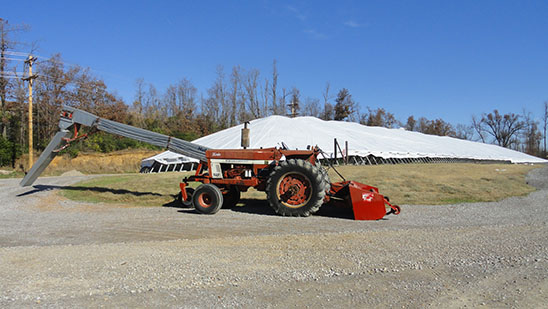UK offers tips on using alternative grain storage
UK offers tips on using alternative grain storage

Published on September 26, 2016
Low grain prices and predictions of record corn and soybean crops in Kentucky have many farmers looking at storage options this year. Some have added grain bins to their existing system in recent years, while others are looking at alternative storage, such as farm shops, covered outdoor piles, grain bags or other structures.
The U.S. Department of Agriculture's September crop report predicts a record U.S. corn crop of 15.1 billion bushels and record soybean production at 4.2 billion bushels. Projections for Kentucky are 242.5 million bushels for corn and 91.3 million bushels for soybeans--both record yields according to the Kentucky Agricultural Statistics Service.
Sam McNeill, University of Kentucky extension agricultural engineer, reminded farmers who plan to store grain in alternative structures this fall to remember some key factors to minimize grain spoilage.
“A producer’s job really isn’t done until grain has passed grade at the elevator and is sold,” said McNeill, associate extension professor in the UK College of Agriculture, Food and Environment. “The diligence spent scouting fields during the growing season should transfer over to managing stored grain."
Properly dried and cooled grain that is protected from pests, aerated and regularly inspected will store well with little chance of excess spoilage, and subsequent price dock, when delivered for sale. Clean, undamaged grain is best for temporary storage when farmers use less-than-ideal facilities. Producers should thoroughly clean alternative storage structures before putting grain in them, fill them last and empty them first.
Farmers should hold grain that is not cleaned to remove broken kernels and trash should at lower moisture levels to minimize spoilage. Producers should aim for 13 percent moisture content in corn they plan to hold through February. They should store soybeans at 11 percent moisture content for the same period.
Producers should evaluate alternative structures for wall strength, capacity, filling and unloading needs and aeration requirements, McNeill said. Most commercial storage buildings have built-in or add-on packages for providing adequate sidewall strength for grain storage. The UK Cooperative Extension Service has plans available for freestanding bulkhead walls up to 6 feet high built from standard lumber and plywood. These can be placed across the open end of a building or adjacent to existing walls to provide adequate strength.
By installing commercially available metal walls with perforated sections for aeration, producers can create covered outdoor piles. McNeill recommends installing a well-packed surface with fine gravel and covering it with heavy plastic to provide a moisture barrier and facilitate unloading. Producers should have aeration tubes in place prior to filling and continue to install them as the pile grows.
Producers can fill flat storage buildings and grain piles by moving a portable auger down the center of the structure. They often use grain vacuum systems, portable augers and front-end loaders to unload grain from these structures.
Proper aeration is essential for successful grain storage and is the key to maintaining uniform temperatures, which control moisture migration and subsequent spoilage of the grain. Producer should run aeration fans at least once a month in flat storage buildings and continuously in covered piles to hold down the cover.
Farmers should space aeration ducts in flat storage buildings so that equal amounts of grain are ventilated with each tube. A rule of thumb for level piles is that the duct spacing should not exceed grain depth, McNeill said. Aeration fans should provide 250 cubic feet per minute of airflow for each 1,000 bushels of grain in the pile.
Rodent, bird and insect control is usually more difficult in flat storage buildings, piles and bags because of inherent exposure. Producers must commit to routine monitoring and use pest control practices to minimize grain spoilage during storage. This includes quickly repairing plastic covers and bags when damage occurs, McNeill said.
Storage cost figures vary widely depending on the type of structure, its original condition and holding capacity. Farmers can use a spreadsheet available on the UK Department of Biosystems and Agricultural Engineering website, https://www.uky.edu/bae/grain-storage-systems/, to estimate the amount of grain these types of structures can hold. They should enter the dimensions of the structure, pile or bag to calculate storage capacity in bushels. County offices of the UK Cooperative Extension Service have more information on managing stored grain in bins or alternative structures.
Biosystems Ag Engineering Extension

